
Exploring the Influence of Charging Infrastructure Proximity
on BEV Adoption at the Municipal Level in Norway
ECONOMICS OF ENERGY

This study investigates the relationship between charging infrastructure proximity and BEV adoption in Norway at the municipal level. Correlation analysis identifies significant associations between BEV share and income, education, electricity prices, and population density. Geospatial regression analysis reveals robust and statistically significant impacts for both registered and proximity points, using three different radii and three different model specifications. The results show that the impact of registered points is stronger than that of proximity points when the buffer zone radius is set to 10 kilometers, but this relationship reverses when the radius is increased to 20 kilometers. These findings highlight the importance of addressing range anxiety in promoting BEV adoption and emphasize the positive influence of charging infrastructure proximity as the buffer zone distance increases.
by Mathieu Breier, Susanna Recusani, Karianne Reinertsen
July, 2023
In the fight against climate change, reduction in CO2 emissions from road transport stands as a crucial factor. Recognizing its significance, we have chosen to focus our investigation on the Norwegian Battery Electric Vehicle (BEV) market. The success of Norway’s market for BEVs has been nothing short of remarkable. In April 2023, the country achieved a groundbreaking milestone, with over 90% of all cars sold being BEVs [5]. This exceptional achievement can be attributed to a combination of factors, including the effective policies implemented by the Norwegian government. Notably, Norway was one of the first countries to introduce tax incentives for BEV purchases, which played a significant role in driving up demand [12]. However, one of the most influential policies that contributed to the success of BEVs in Norway is the establishment of a robust charging infrastructure network.
Ensuring widespread accessibility to charging points throughout the country has been instrumental in making BEVs a viable option for Norwegian consumers. Norway’s unique geographical characteristics, such as long distances and extreme cold weather conditions, have traditionally contributed to range anxiety, making potential BEV owners hesitant. However, by strategically installing charging infrastructure and providing easy access to charging points, the Norwegian government and private firms have successfully alleviated these concerns and created an enabling environment for BEV adoption.
In our research, we place a particular focus on the geospatial analysis of charging infrastructure and its impact on BEV adoption in Norway. By incorporating geospatial computations and employing buffer zone calculations, we are able to quantify the accessibility of charging points for each municipality. This approach allows us to examine the spatial distribution of charging infrastructure and its influence on BEV adoption patterns across the country. Furthermore, to analyze the factors influencing the establishment of registered points, we constructed a secondary model incorporating the BEV share and the proximity of charging points, along with the relevant covariates.
Moreover, we consider the demographic and geographic characteristics of municipalities to gain a comprehensive understanding of the factors influencing BEV adoption. By analyzing how factors such as population density, income levels, education, and electricity prices correlate with BEV adoption rates, we aim to provide valuable insights into the drivers of BEV uptake in different regions of Norway.
To enhance the robustness of our analysis, we employ a combination of geospatial analysis and econometric methods. By integrating these approaches, we can capture the complex relationships between charging point proximity, demographic variables, and BEV adoption. Additionally, we incorporate lags in our regression models to address potential endogeneity issues and capture the dynamic nature of the relationship between charging infrastructure and BEV adoption over time.
Our research builds upon previous studies in the field. In particular, we draw inspiration from the work of Reinertsen and Recusani in their study on “Public and Private Investment in BEV Charging Infrastructure and Spillover Effects” [16]. While their Master’s project provided valuable insights into the initial patterns of investment and BEV adoption, our current research takes a distinct path. We aim to estimate the causal relationship between proximity points and the change in the share of BEVs, utilizing a different dependent variable, a different model specification, and incorporating additional data from the year 2009. Furthermore, we focus on a smaller subset of 295 municipalities to investigate potential spillover effects.
By integrating geospatial analysis techniques with econometric modeling, our research aims to provide a comprehensive and nuanced analysis of the role of charging infrastructure in BEV adoption and shed light on investment patterns in Norway’s charging points. The findings from our study have important implications for policymakers, industry stakeholders, and researchers seeking to promote sustainable transportation and inform strategic decision-making in the field of electric vehicle infrastructure.
Our study aims to make a significant contribution to the existing literature on the Norwegian battery electric vehicle (BEV) market by investigating the impact of charging point proximity on BEV adoption in Norwegian municipalities. Norway has garnered international attention for its remarkable success in BEV adoption, largely attributed to the government’s long-standing support and favorable policies [7]. However, the availability of reliable and accessible charging infrastructure remains a critical factor in facilitating the widespread adoption of BEVs [14] [18].
Charging infrastructure plays a pivotal role in overcoming the psychological barrier of range anxiety, which refers to the fear of running out of battery charge and being stranded without a charging option, even when the battery still has significant remaining autonomy. [15] [6] [10]. These barriers are most challenging to cross in such a cold country, where batteries are very likely to underperform. Mashoodi and van der Blij [11] have demonstrated that this fear may necessitate a substantial increase of charging points by 167% in the charging infrastructure of Amsterdam. However, as the number of charging points increases, we anticipate that this type of anxiety can be alleviated, potentially leading to even greater spillover effects. Our study is conducted in a context where charging points are densely distributed across the territory, allowing us to explore the relationship between charging point proximity and BEV adoption more comprehensively.
By ensuring convenient access to charging points, potential BEV owners can gain the confidence to make the transition from traditional gasoline-powered vehicles to electric vehicles. This aspect has been recognized by governments and businesses worldwide, leading to significant investments in the development of charging infrastructure, including public charging stations in urban areas and along major highways [14] [18].
The cultural significance of cabins in Norway, with around 43% of the population having access to one, has played a pivotal role in shaping our geospatial analysis [1]. Understanding Norwegians’ attachment to these cabins further emphasizes the importance of charging infrastructure in neighboring municipalities. This aspect of range anxiety, related to safely reaching remote cabin locations and finding reliable electricity, highlights the necessity of addressing charging infrastructure concerns to facilitate the widespread adoption of sustainable transportation options in the country [13].
While efforts have been made to study the impact of publicly available charging infrastructure [17], little is known still about the spillover effects due to installations in neighbouring municipalities. Reinertsen and Recusani[16] used two different models to try and quantify such effects. They find conflicting results relative to their magnitude and direction. Additionally, while they do manage to reduce this concern, they never apply a specification that completely excludes endogeneity, and thus they cannot claim causality. Our aim is to expand on their research, using a specification that prevents endogeneity, and to accurately quantify spillover effects.
In the context of Norway, the charging infrastructure ecosystem has evolved to encompass various types of charging, including home, workplace, and public charging options [9] [8] [17]. Our research specifically focuses on the impact of charging points located in municipalities’ proximity, on BEV adoption in Norwegian municipalities. By considering the geographic distribution of charging points, we aim to provide valuable insights into the role of infrastructure in promoting the adoption of sustainable transportation options.
Furthermore, our study takes into account the unique demographic characteristics of Norwegian municipalities and their potential influence on BEV adoption patterns. In particular, Norway has an outstandingly homogeneous distribution of income and high levels of education, attributes which might contribute to the success of electric mobility. By analyzing the demographic attributes of municipalities, we seek to identify additional factors that may shape the relationship between charging point proximity and BEV adoption. Understanding these contextual factors can help policymakers and stakeholders in developing effective strategies to further encourage BEV adoption and create a sustainable transport ecosystem.
In summary, our research endeavors to advance the understanding of the Norwegian BEV market by investigating the impact of charging point proximity on BEV adoption in municipalities. Through a comprehensive analysis that incorporates geographic considerations, we aim to provide valuable insights into the role of charging infrastructure in promoting the widespread adoption of BEVs, contributing to the ongoing global transition towards sustainable transportation.
To construct our panel data for analysis, we collected data from NOBIL [2], the Norwegian National Statistics website [4], the UC Davis database of global administra- tive areas (GADM) [19], and Nordpool [3]. These sources provided crucial information that contributed to the comprehensive nature of our study.
The NOBIL dataset proved invaluable in providing detailed information about registered charging stations in Norway. It furnished us with precise spatial positions and exact date of establishment for each charging station. While the exact construction dates were not available, we used the time of addition to the NOBIL database as a proxy. Since NOBIL was established in March 2010, we made the assumption that charging points registered between March and May 2010 were already established in 2009. We make the assumption that these charging stations were established in 2009 because the government announced their plan to establish charging infrastructure across the country in 2008. Thus, for our analysis, we included data spanning from 2009 to 2022.
Demographic data for the municipalities and the dependent variable, BEV share, were obtained from Statistics Norway. The registered vehicles dataset provided information on the number of cars registered by fuel type in each municipality, allowing us to calculate the BEV share. Our demographic variables encompassed population density, median household income, educational attainment, and average age at the municipality level.
Furthermore, we acquired a dataset from Nordpool, which operates Europe’s leading power market. This dataset offered insights into monthly electricity prices between 2009 and 2022 for different regions, namely NO1-NO5, representing North, West, South, East, and Middle regions in Norway. Notably, the southern regions experienced higher electricity prices following the Ukrainian war due to their connection to separate grids. This additional data facilitated further comparisons at a more aggregated level.

To complement our panel data, we utilized raster data from the UC Davis GADM database. However, it is important to acknowledge that the raster data we obtained did not reflect the current municipal boundaries due to municipal mergers and separations over time. As seen in figure 1, to ensure the accuracy of our analysis, we excluded 61 municipalities from our dataset, focusing on 295 municipalities that accurately represented the current administrative boundaries. This allowed us to conduct a robust examination of the relationship between charging point proximity and BEV adoption in the Norwegian context.
In our data section, we distinguish between two types of charging points that may impact the demand for BEVs in a municipality: registered points and proximity points. Registered points correspond to the original NOBIL specification, where a charging point is registered in the municipality within whose geographical area it falls.
To create the dataset for proximity points, we followed a specific procedure. First, we split the NOBIL points into different datasets using R. Next, we uploaded these CSV files as delimited text files in QGIS. For each charging point, we created a buffer zone around it with radii of 10, 15, and 20 km. The selection of 10km, 15km, and 20km as the buffer zone radii in our analysis is based on the national average daily travel distance in Norway, which is approximately 31 km [4]. Then, we joined the buffer zone layers with the raster data by utilizing the intersect function, which allowed us to identify every point registered in all municipalities it intersected with. Subsequently, we saved these joined layers as CSV files in three separate folders, each representing a different buffer zone radius. Finally, using R, we merged the datasets and performed necessary computations to generate new variables.
This process resulted in a dataset encompassing the cumulative number of registered points and proximity points for each municipality from 2009 to 2022. By incorporating both registered and proximity points, we aimed to capture a comprehensive picture of the charging infrastructure and its potential influence on BEV demand at the municipality level.
As seen in table 1, the number of municipalities that have proximity to charging infrastructure is much higher in the first years of the dataset, while the numbers converge towards the end of the time period.
As depicted in Figure 2, the BEV share trend reveals an interesting pattern. Despite the “No Registered Points” group of municipalities, which never received charging points within their borders, exhibiting relatively lower BEV shares throughout the dataset’s time span, they still demonstrate a positive BEV share. Remarkably, these municipalities are not far behind the counterparts with one or more registered charging points. This intriguing observation serves as a motivation for our geospatial analysis, as it suggests the presence of potential spillover effects among municipalities. We hypothesize that the proximity of charging points to a given municipality may alleviate range anxiety and enhance BEV mobility, influencing their adoption rates.
In summary, our study relied on data from NOBIL, the Norwegian National Statistics website, GADM, and Nordpool, as well as the foundational research by Reinertsen and Recusani, to construct a comprehensive panel dataset. These data sources provided essential information on charging infrastructure, demographics, electric- ity prices, and administrative boundaries, enabling us to investigate the relationship between charging point proximity and BEV adoption in the Norwegian BEV market while expanding upon previous work and exploring potential spillover effects.
| Year | Registered points | 10km | 15km | 20km |
|---|---|---|---|---|
| 2009 | 83 | 143 | 160 | 179 |
| 2010 | 90 | 146 | 161 | 181 |
| 2011 | 94 | 150 | 165 | 184 |
| 2012 | 112 | 162 | 177 | 198 |
| 2013 | 132 | 180 | 195 | 213 |
| 2014 | 152 | 199 | 218 | 235 |
| 2015 | 167 | 216 | 232 | 244 |
| 2016 | 183 | 227 | 240 | 252 |
| 2017 | 200 | 242 | 251 | 261 |
| 2018 | 220 | 249 | 257 | 265 |
| 2019 | 230 | 253 | 260 | 268 |
| 2020 | 242 | 268 | 274 | 281 |
| 2021 | 251 | 275 | 280 | 285 |
| 2022 | 256 | 278 | 280 | 285 |
| No points | 39 | 17 | 15 | 10 |
Notes: The table compares the number of municipalities that have 1 or more charging points by specification. The columns represent the Registered point, 10km, 15km, and 20km specification. There are 295 municipalities in total.
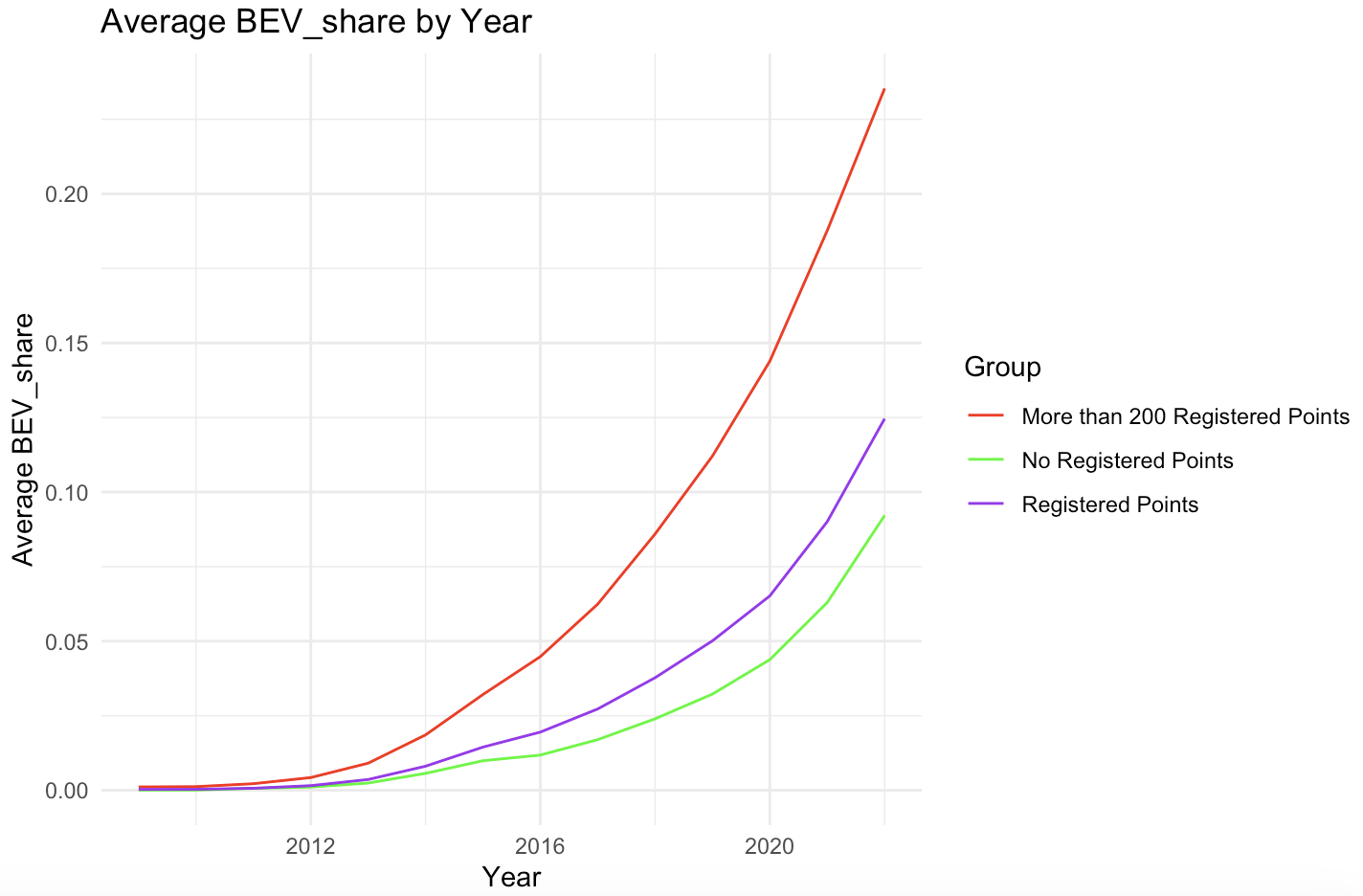
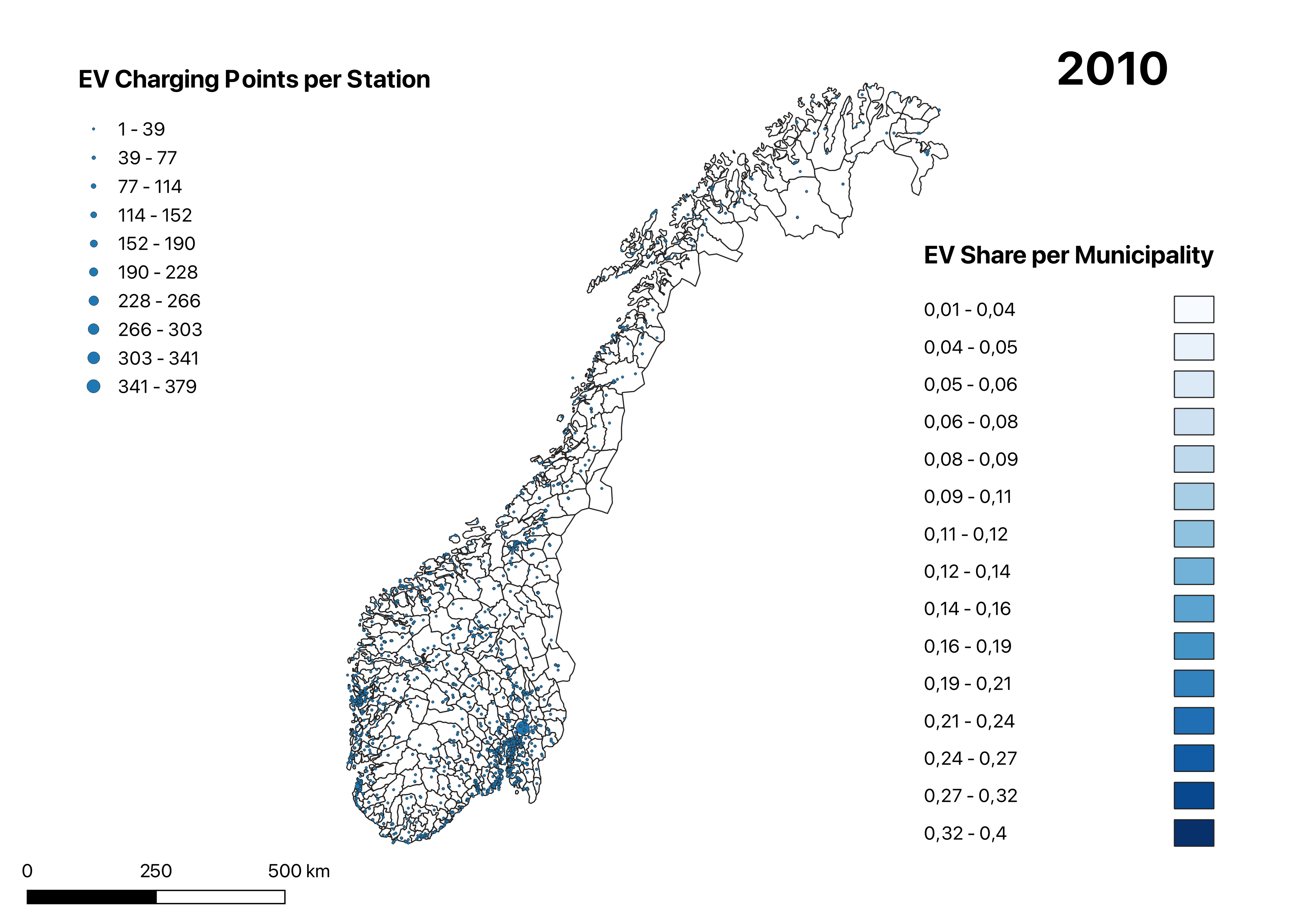
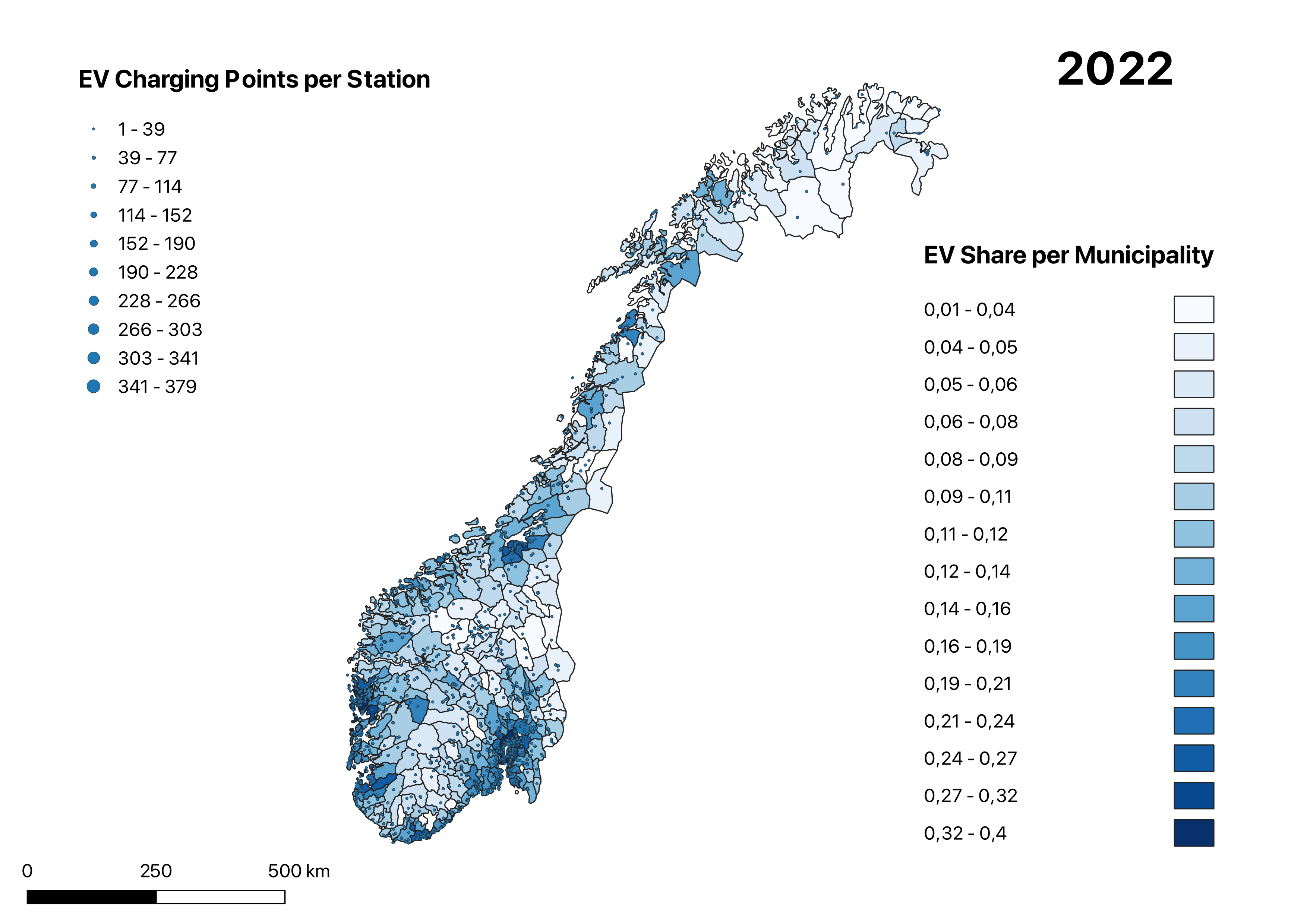
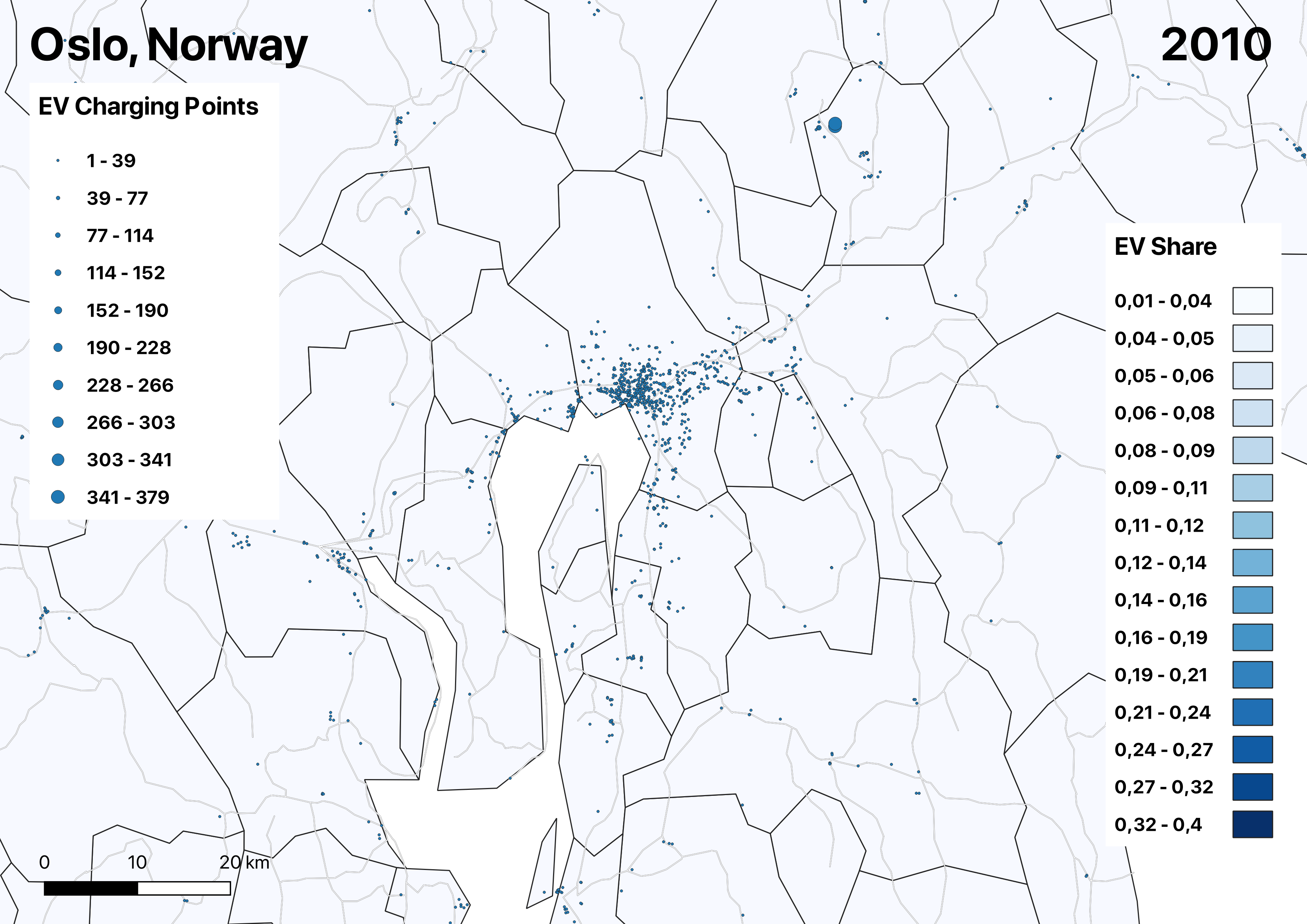
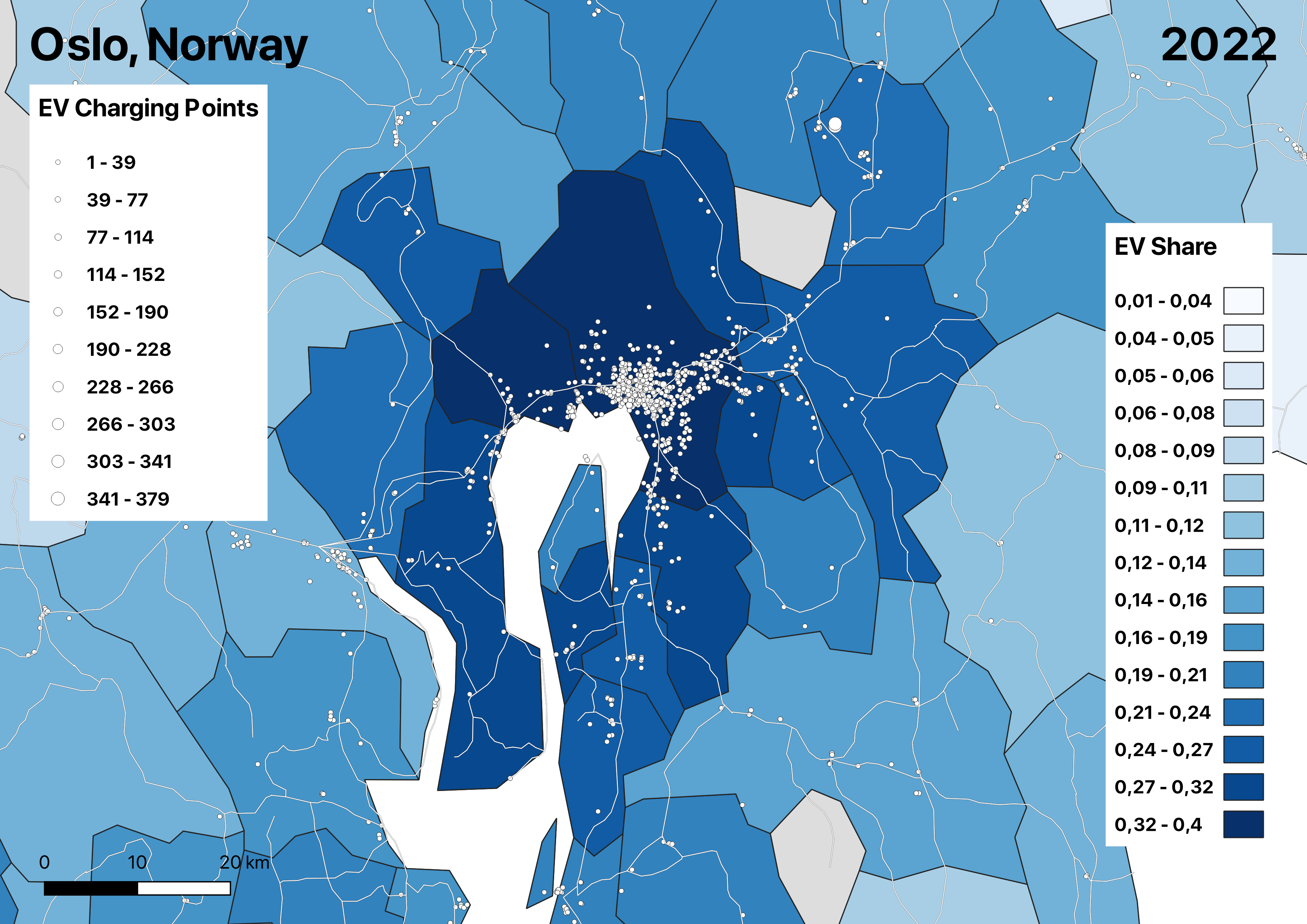
In this study, we first conduct a correlation analysis between the variable of interest, BEV share, and other variables in our dataset. The objective is to examine the strength and direction of the relationships between BEV share and the other variables from our panel data. We set a significance threshold of 0.05 for the maxi- mum p-value to identify statistically significant correlations. This analysis provides valuable insights into the associations between BEV share and other variables, shedding light on potential factors that may influence the adoption and usage of electric vehicles. The analysis uses the years 2009-2022.
In our analysis, we investigate the spillover effects between municipalities, and the influence charging points have on Battery Electric Vehicle (BEV) demand in municipalities. We differentiate between Registered and Proximity points.
The panel data analysis employs a regression model with the BEV share as the dependent variable. The model incorporates fixed effects for municipality and year, along with other relevant demographic variables. We will use the correlation anal- ysis to determine which demographic variables to control for in our analysis. By examining the regression results, we can assess the impact of proximity to charging points on BEV adoption while controlling for demographic factors. The model uses data from 2009-2022.
The baseline specification for our Fixed Effects Panel Data Model to examine the relationship between proximity to charging points and BEV adoption in Norway’s municipalities is as follows:
$$\Delta BEV\_{\text{share}}_{i,t} = \beta_0+ \eta_i + \theta_t + \beta_1 \cdot \text{Registered points}_{i,t-1} + \beta_2 \cdot \text{Proximity points}_{i,t-1} + \varepsilon_{i,t} $$
Where:
\(\Delta\) BEV_\(\text{share}_{i,t}\) represents the change in share of electric vehicles in municipality \(i\) from time \(t-1\) to time \(t\).
\(\eta\) is the fixed effect by municipality.
\(\theta\) is the fixed effect by year.
Registered_points is the cumulative sum of charging points registered to municipality \(i\) in year \(t-1\).
Proximity_points is the cumulative sum of the buffer charging points in the given proximity (10, 15, 20km) to municipality \(i\) in year \(t-1\).
\(\varepsilon_{i,t}\) is the error term.
Two elements constituted a threat to the soundness of our study: endogeneity and the powerful mix of policies in order to promote BEV adoption implemented in Norway.
The first is a common concern in studies on the relationship between charging points and BEVs : while it is clear that the former affect the latter, there can also be some reverse causality. While second element is an undisputed asset in Norway’s race to a net-zero car market, it is a challenge, from an econometric point of view: if we are unable to accurately isolate the effect of charging infrastructure from these policies, our results might be biased.
These concerns led us to our choice of the econometric model. By picking as our dependent variable the change in percentage of registered BEVs and using as regressors the lagged cumulative number of registered and proximity charging points, we avoid endogeneity; in fact, it would be impossible for our dependent variable to directly affect the number of charging points within the same period. This allows us to infer a causal relationship. Additionally, we believe that using lagged regressors has another advantage: it allows us to take into account the fact that decisions relative to purchasing a car, and even more so an Electric Vehicle, is rarely immediate or impulsive, and that turnover of cars is rather slow. We expect additional charging points to have effects on uptake only after some time; this is perfectly reconciled with our choice of control variables. We include time and municipality fixed effects, which we believe will enable us to capture the effects of policies that were applied nation-wide and might have influenced BEV uptake, consider market-cycles, as well as local characteristics that might influence uptake in some municipalities.
By incorporating fixed effects for municipality and year, along with relevant demographic variables, we examine the affect of Registered and Proximity points on BEV adoption.
After conducting our first geospatial analysis, our final aim is to examine the relationship between proximity points in time period t-1 and the corresponding registered points in time period t. Specifically, we aim to investigate whether an increase in proximity points from the previous year is associated with an increase or decrease in registered charging points. By analyzing this relationship, we can gain insights into how the availability of charging infrastructure, as measured by proximity points in the previous time period, influences the establishment of charging points in different municipalities.
$$\Delta Registered\_Points_{i,t} = \beta_0+ \eta_i + \theta_t + \beta_1 \cdot \text{BEV Share}_{i,t-1} + \beta_2 \cdot \text{Proximity points}_{i,t-1} + \beta_3 \cdot \text{Income}_{i} +$$
$$\beta_4 \cdot \text{Density}_{i,t} + \beta_5 \cdot \text{Electricity Price}_{i,t} + \beta_6 \cdot \text{Education}_{i,t} + \varepsilon_{i,t} $$
Where:
\(\Delta\) \(\text{Registered_Points}_{i,t}\) represents the change in registered electric vehicles in municipality \(i\) from time \(t-1\) to time \(t\).
\(\eta\) is the fixed effect by municipality.
\(\theta\) is the fixed effect by year.
\(BEV\ share\) is the share of BEVs in municipality \(i\) in year \(t-1\).
\(Proximity\ points\) is the cumulative sum of the buffer charging points in the given proximity (10, 15, 20km) to municipality \(i\) in year \(t-1\).
Densityi,t represents the density in municipality \(i\) in year \(t\).
Educationi,t represents the education level in municipality \(i\) in year \(t\).
Electricity pricei,t represents the electricity price in municipality \(i\) in year \(t\).
Incomei,t represents the income level in municipality \(i\) in year \(t\).
\(\varepsilon_{i,t}\) is the error term.
In Figure 4, we observe significant relationships between our selected variables and the dependent variable, BEV share. Among these variables, Income exhibits the highest correlation with a coefficient of 0.706, indicating a strong positive relationship. This finding aligns with our expectations as higher income levels are often associated with increased purchasing power and a greater likelihood of affording electric vehicles. Additionally, Education shows a strong relationship, suggesting that individuals with higher education levels may be more inclined to adopt electric vehicles. The impact of education on BEV share can be further explored by considering factors such as environmental awareness, technological familiarity, and sustainability values.
Another noteworthy variable is Electricity prices, which demonstrates one of the strongest correlations with BEV share. This finding is logical since electricity prices directly impact the overall cost of driving a car after its purchase. Higher electricity prices may discourage the adoption of electric vehicles due to concerns about ongoing expenses. On the other hand, lower electricity prices could incentivize potential BEV owners by reducing the cost of usage.
Interestingly, Population density shows a stronger relationship with BEV share compared to Population alone. This finding suggests that the concentration of population in a specific area influences the adoption of electric vehicles more significantly than the overall population size. Potential explanations for this relationship could include accessibility to charging infrastructure, availability of public transportation alternatives, and the presence of supportive policies or initiatives in densely popu- lated areas.
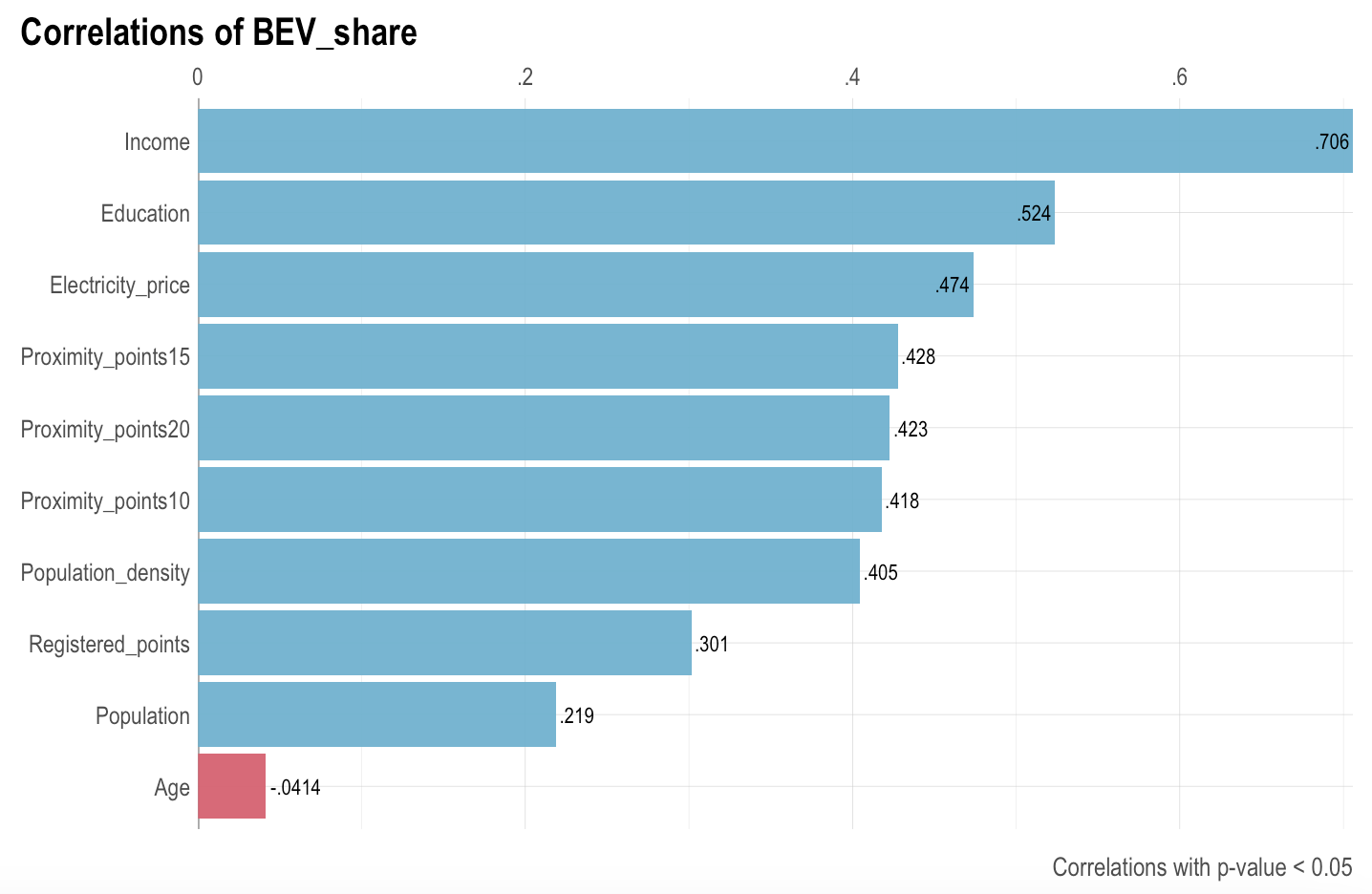
Furthermore, we find that the cumulative proximity points of all radii exhibit a stronger correlation with BEV share than the cumulative registered points. This disparity suggests that the proximity points, which consider mobility beyond immediate travel distances, have a greater impact on BEV adoption by alleviating range anxiety. In contrast, the registered points within close proximity may have a more limited influence on driving BEV adoption.
Table 2 presents the results of a buffer zone comparison for three different panels (Panel 1, Panel 2, and Panel 3) with fixed effects and covariates. The analysis explores the effects of different buffer zone distances (10km, 15km, and 20km) on BEV adoption while accounting for panel-specific factors and other relevant variables.
To account for panel-specific characteristics that may affect the change in BEV share within the buffer zone, fixed effects are included in the analysis. This helps con- trol for any inherent differences across the panels. Furthermore, covariates such as Density, Income, Electricity Price, and Education are incorporated to capture additional factors that could potentially influence the dependent variable. The selection of these covariates in panel 3 was based on the correlation analysis conducted in section 6.1, ensuring that relevant variables are included to provide a comprehensive analysis.
| Dependent Variable | \(\Delta\) BEV\(\text{share}_{i,t}\) | ||||
|---|---|---|---|---|---|
| Distance | Panel 1 | Panel 2 | Panel 3 | ||
| 10km | |||||
| Lag(Registered Points) | 0.008\(^{***}\) (0.0002) | 0.007\(^{***}\) (0.0002) | 0.003\(^{***}\) (0.0003) | ||
| Lag(Proximity Points) | 0.005\(^{***}\) (0.0002) | 0.004\(^{***}\) (0.0002) | 0.002\(^{***}\) (0.0002) | ||
| R\(^{2}\) | 0.652 | 0.675 | 0.733 | ||
| Observations | 2,943 | 2,943 | 2,782 | ||
| Mean BEV Share | 0.0105 | 0.0105 | 0.0107 | ||
| 15km | |||||
| Lag(Registered Points) | 0.007\(^{***}\) (0.0002) | 0.006\(^{***}\) (0.0002) | 0.003\(^{***}\) (0.0003) | ||
| Lag(Proximity Points) | 0.006\(^{***}\) (0.0002) | 0.005\(^{***}\) (0.0002) | 0.003\(^{***}\) (0.0002) | ||
| R\(^{2}\) | 0.673 | 0.694 | 0.739 | ||
| Observations | 2,967 | 2,967 | 2,806 | ||
| Mean BEV Share | 0.0105 | 0.0105 | 0.0107 | ||
| 20km | |||||
| Lag(Registered Points) | 0.005\(^{***}\) (0.0002) | 0.005\(^{***}\) (0.0002) | 0.003\(^{***}\) (0.0003) | ||
| Lag(Proximity Points) | 0.007\(^{***}\) (0.0002) | 0.007\(^{***}\) (0.0002) | 0.003\(^{***}\) (0.0003) | ||
| R\(^{2}\) | 0.685 | 0.705 | 0.739 | ||
| Observations | 2,943 | 2,943 | 2,782 | ||
| Mean BEV Share | 0.0105 | 0.0105 | 0.0107 | ||
| Covariates | |||||
| Electricity Price | No | Yes | Yes | ||
| Density | No | No | Yes | ||
| Income | No | No | Yes | ||
| Education | No | No | Yes | ||
| Fixed Effects | Yes | Yes | Yes | ||
| \(^{*}\)p<0.1; \(^{**}\)p<0.05; \(^{***}\)p<0.01 |
Notes: Table 2 presents a comparison of buffer zones at three different distances (10km, 15km, and 20km) and explores the impact of including covariates (Electricity Price, Density, Income, and Education) in the model specification.
The coefficients presented in the table represent the estimated effects of the variables on our dependent variable, ∆BEV Share. Specifically, the coefficients for “Lag(Registered points)” and “Lag(Proximity points)” indicate the impact of the standardized number of charging points registered and the standardized number of charging points within the buffer zone in year t-1, respectively, on the change in BEV share.
The results in the table provide valuable insights into the relationship between buffer zone distances and BEV adoption, while taking into account panel-specific factors and other relevant variables. The consistent and significant positive coefficients across different panels and buffer distances demonstrate the robustness of our findings, indicating that proximity to charging infrastructure has a reliable and positive effect on BEV adoption.
Looking at the table, we observe that the estimates for proximity points increase as the buffer zone distance expands. This suggests that having charging infrastructure within a larger radius positively influences BEV adoption. As the distance increases, more BEV owners have access to a greater number of charging points, which can alleviate their concerns about range anxiety and contribute to their decision to adopt BEVs.
On the other hand, the estimates for registered points decrease as the buffer zone distance increases. This implies that the specific charging points registered within the buffer zone have a relatively smaller impact on BEV adoption as the prospective travel distance expands. Other factors, such as proximity to charging infrastructure in neighboring areas, become more influential in driving BEV adoption.
One possible explanation for this pattern is that as the buffer zone distance increases, our analysis considers a larger number of proximity points. These proximity points capture spillover effects from charging infrastructure located near the buffer zone but outside of the specific registered points. By incorporating a broader geographical area, we account for a wider range of factors that contribute to BEV adoption and capture the variation attributed to these spillover effects.
The findings presented align with existing research on BEV charging infrastructure and contribute to the understanding that range anxiety plays a significant role in shaping users’ confidence in the ability of BEVs to meet their travel requirements beyond short distances. These results underscore the importance of addressing range anxiety as a crucial factor in promoting wider acceptance and usage of BEVs.
After conducting a second geospatial analysis, we present the results in Table 3 below. Our subsequent analysis revealed significant coefficients for both Proximity points and BEV share in year t-1. However, it is important to note that the overall explanatory power of the model is relatively weak.
| Dependent Variable | \(\Delta\) Registered Points | |||
|---|---|---|---|---|
| Distance | 10km (1) | 15km (2) | 20km (3) | |
| Lag(Proximity Points10) | 3.959\(^{***}\) (0.633) | |||
| Lag(Proximity Points15) | 4.807\(^{***}\) (0.756) | |||
| Lag(Proximity Points20) | 5.543\(^{***}\) (0.912) | |||
| Electricity price | 0.326 (0.465) | 0.305 (0.455) | 0.252 (0.451) | |
| Density | 1.646\(^{***}\) (0.517) | 1.819\(^{***}\) (0.511) | 1.920\(^{***}\) (0.505) | |
| Educ | -1.465 (1.493) | -1.736 (1.474) | -1.738 (1.447) | |
| Income | -1.552 (1.606) | -1.986 (1.595) | -2.618 (1.600) | |
| Observations | 2,996 | 3,0506 | 3,077 | |
| R\(^{2}\) | 0.073 | 0.072 | 0.071 | |
| Adjusted R\(^{2}\) | -0.017 | -0.018 | -0.020 | |
| F Statistic | 35.658\(^{***}\) (df = 6; 2731) | 36.050\(^{***}\) (df = 6; 2780) | 35.480\(^{***}\) (df = 6; 2804) | |
| \(^{*}\)p<0.1; \(^{**}\)p<0.05; \(^{***}\)p<0.01 |
Notes: Table 2 presents a comparison of buffer zones at three different distances (10km, 15km, and 20km) and explores the impact of including covariates (Electricity Price, Density, Income, and Education) in the model specification.
The coefficients indicate that an increase in proximity points from the previous year is associated with a positive change in Registered points. Additionally, a higher BEV share in the previous year is also positively associated with an increase in registered points. The coefficients for the covariates are not significant, with the exception of Density, which shows a positive relationship with BEV share. These findings suggest that the availability of charging infrastructure, as measured by proximity points, and the previous adoption level of BEVs play a role in the decision to establish new registered charging points in municipalities.
While creating the variable for proximity points, we followed a procedure involving the creation of buffer zones around each charging point and intersecting them with the respective municipality borders. However, upon careful evaluation and with the guidance of our professor, we recognized that an alternative method where we create buffer zones around each municipality would likely have been more efficient in terms of computational resources and processing time.
By generating buffer zones around each municipality instead of each individual charging point, we could have significantly reduced the number of spatial intersections and computations required. This approach would have allowed for more streamlined data processing and quicker analysis.
Nevertheless, despite the potential efficiency gain of the alternative method, we proceeded with our initial approach as it ultimately yielded comparable results. The process of creating buffer zones around each charging point with varying radii of 10, 15, and 20 km allowed us to investigate the impact of charging infrastructure at different distances on BEV adoption, providing valuable insights into the role of proximity in addressing range anxiety and promoting BEV uptake.
Our analysis revealed several significant findings. Firstly, there is a strong positive correlation between Income and BEV share, indicating that higher income levels contribute to greater electric vehicle adoption. This aligns with countries like Nor- way, known for their high average incomes and favorable wealth distribution, where a larger proportion of the population can afford BEVs. Secondly, Education is positively correlated with BEV share, suggesting that individuals with higher education levels are more inclined to adopt electric vehicles, possibly due to factors such as environmental awareness and technological familiarity. Additionally, Electricity prices demonstrate a strong correlation with BEV share, as they directly influence the cost of operating electric vehicles. Higher electricity prices may deter adoption, while lower prices can incentivize potential owners. Lastly, Population density has a stronger relationship with BEV share than overall Population, implying that concentrated areas influence electric vehicle adoption more significantly. Factors such as charging infrastructure, public transportation options, and supportive policies play a role in this relationship.
The finding that proximity points consistently exhibited a higher correlation with BEV share compared to registered points across all radii suggests that spatial proximity plays a crucial role in influencing BEV adoption. This discrepancy suggests that the proximity points, which take into account mobility beyond immediate travel distances, have a more significant impact on BEV adoption by addressing concerns related to range anxiety. In contrast, the registered points within close proximity may have a more limited influence on driving BEV adoption. This implies that the availability of charging infrastructure and supportive services in broader geographic areas plays a crucial role in alleviating range anxiety and promoting the adoption of electric vehicles.
The results of our analysis reveal that proximity to charging infrastructure has a positive effect on BEV adoption, as indicated by the significant and positive coefficients for both registered points and proximity points. The findings suggest that having charging points within a larger buffer zone increases BEV adoption, potentially reducing range anxiety and boosting confidence in the availability of charging infrastructure.
The decreasing estimates for registered points imply that factors beyond the specific registered charging points, such as proximity to charging infrastructure in neighboring areas, play a more influential role in driving BEV adoption. This highlights the importance of considering spillover effects and broader geographical areas in analyzing BEV adoption patterns. These findings also stress the importance of accounting for spillover effects in studies on range anxiety, and that distance to charging infrastructure seems to be more important than whether there is charging infrastructure within the borders.
Our analysis reveals that both proximity points and the previous year’s BEV share have significant coefficients in predicting the establishment of new registered charg- ing points. These findings emphasize the importance of accessible charging infras- tructure and the existing adoption level of electric vehicles in driving the expansion of registered points. However, it is important to recognize that the model’s explana- tory power is limited, indicating that there are likely other factors influencing the establishment of new registered points that are not captured in our current model. Factors such as policy incentives, market demand, and specific local conditions may also contribute to these decisions. Therefore, while the coefficients provide valuable insights, they should be interpreted with caution, and further research is needed to fully understand the determinants of new registered charging points in municipalities.
In conclusion, our study focused on the adoption and usage of Battery Electric Vehicles in Norwegian municipalities, emphasizing the role of charging infrastructure and proximity points. Our analysis provided valuable insights into the key factors driving BEV adoption.
The results highlight the significance of charging infrastructure and spatial proximity in influencing BEV adoption. Accessible charging points within proximity played a crucial role in adoption, surpassing registered points and addressing range anxiety. Higher income and education levels were found to positively impact adoption, while higher electricity prices were an obstacle.
With our chosen specification, we aimed to minimize biases and isolate the effect of spillover effects. The analysis consistently showed that proximity points positively influenced BEV adoption, with larger buffer zones capturing more of the impact on BEV adoption.
The findings underscore the need for policymakers to expand charging infrastructure networks to enhance the confidence and convenience of potential BEV owners. Addressing range anxiety through accessible charging points beyond immediate travel distances is crucial for promoting BEV adoption.
While our study contributes valuable insights, there are limitations to our models and opportunities for further research to explore the impact of specific policies on BEV adoption. Future studies could also assess alternative proximity point calculations for increased efficiency.
Our secondary model revealed a positive influence of both the BEV share and proximity points on the establishment of registered points; however, we acknowl- edge the limited explanatory power of the model, that indicates its inability to account for a significant portion of the variation in the establishment of registered points.
In summary, our study expands the understanding of the factors driving BEV adop- tion in Norway. The findings emphasize the importance of charging infrastructure and spatial proximity, providing guidance for policymakers and stakeholders aiming to accelerate the transition to a sustainable and decarbonized transportation system powered by electric vehicles.
You can contact me through my email: mathieu.breier@bse.eu
You can download my CV here
Follow me on these social media platforms:
Github: https://github.com/mtbrr26
LinkedIn: https://www.linkedin.com/in/mathieu-breier/
© Mathieu Breier